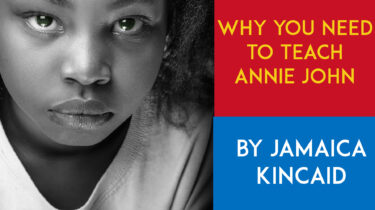Why You Need to Teach Annie John by Jamaica Kincaid

I first started teaching Annie John in the early 2000s, and it’s always been a surprise to me that it’s not more of a staple in high school English Classes. With themes of growing up and coming of age, it’s such a classic choice for teens, and yet it doesn’t focus on white boys and their problems, and so it’s refreshing and compelling. (Now that I think about it, maybe that’s the real reason why it isn’t taught more often….)
I’m always on the lookout for a great text that will impact my students and also be enjoyable to teach. And when I do find that gem, I want other high school teachers to experience it as well. I created this unit on Annie John, and now I want everyone to experience Kincaid’s masterful novel as well!
So if you’re not already teaching Annie John, here’s where I convince you why you need to add it to your plans.
It’s both a “window” and a “mirror.” Most of your students will likely not know first hand what it is like to grow up on an island in the Caribbean, and this short novel does a lovely job of capturing everyday life in Antigua. Glimpses of Annie’s unique neighbors, teachers, and other schoolmates also offer students a vision of a life that is not like their own. On the other hand, the experiences of growing up as portrayed in the novel are so universal that just about anyone can relate. Kincaid masterfully puts into words the feelings, frustrations, and experiences of being a child and a teen in a world that was not created just for your existence.
The unparalleled depth of ideas and richness of language. I’ve taught Annie John with many AP Lit classes over the years, and they are always surprised at how deep our discussions go and just how much there is to analyze in the novel. This is surprising because it’s essentially an “easy” book to read, and yet in our short time on the novel, we can really dig deep. This is especially nice in a class like AP Literature where I want students to practice analyzing and writing about literature without having to slog through a 300+ page book first. But it’s also great for a class full of students who don’t really like reading because, well, there isn’t that much to read!
Students love autobiographical fiction (and fictionalized autobiography). There is something that is just endlessly engaging and compelling about autobiographical fiction, especially when it feels as real as this book does. Students love to question what “really” happened, and so many details align with Kincaid’s life that it’s hard not to read this as a vulnerable and revealing autobiography. And yet Kincaid has said “Lying is the beginning of fiction.” She is truly a great writer who blurs the line and teases us with what’s true and what’s false and what we even mean when we say true and false.
“Lying is the beginning of fiction.”
Jamaica Kincaid
The challenging yet fascinating structure of the novel. Annie John is episodic but also follows the standard plot structure in an interesting way. Just as students will enjoy wrestling with questions around what’s “real” and what’s “fake” in the book, they will be pleasantly challenged by the structure of the novel. Sometimes it’s hard to tell how old Annie is or if the book has gone back in time or what. And yet, that’s the way that memory works, and it’s how we all see our own lives. And then, once students have finished, they’ll realize that the book actually follows the standard plot structure with rising action, a climax, and a resolution. This kind of innovative structure makes for great discussion and opens up students’ ideas on what a novel can be.
Kincaid grapples with important themes around of imperialism and power. Whether she is battling the expectations of her all-powerful mother or vandalizing a school book that glorifies Christopher Columbus, Annie is constantly working to dismantle the power structures around her. When her individual story is read in the context of years of crushing colonialism in Antigua, her everyday struggles take on more depth and meaning. (I highly recommend reading at least an excerpt from Kincaid’s book-length essay “A Small Place” for the historical context—plus it’s another powerful, accessible, and masterfully written text.)
It’s a whole book focused not just on a Black girl but on an angry, powerful, and sometimes unlikable Black girl. As important as it is to read diverse books in your English classes, it’s just as important to read books that portray Black and Brown kids as full human beings. Annie is complex and real, and that means that sometimes she doesn’t make the right decisions, sometimes she fights back against oppressive authority figures, and sometimes she gets angry. She isn’t always likable and she’s definitely not perfect. She is a complex character, though, someone with deep thoughts and experiences, and while that doesn’t always make her the most likable character, it does make her very real.
All this in 160 pages. Did I mention how short this powerful book is? It’s short enough to read it all out loud in class and discuss the book in two weeks or to have students finish it in a week if they’re reading on their own for homework. It’s 160 pages—but actually it’s even shorter than that as those are pages with big margins and big print!
Want to teach this should-be-a-classic as well as Kincaid’s masterful short story “Girl” and an excerpt from her biting and relevant essay “A Small Place”? Check out my complete unit on Annie John and get ready-to-go lessons which you can start teaching tomorrow.
Cover Credit: Photo by Wadi Lissa on Unsplash